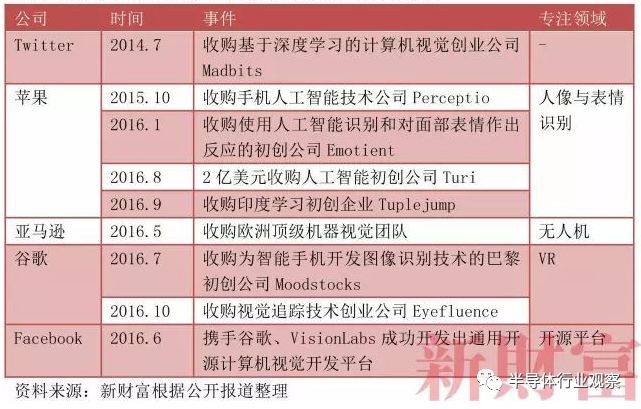

Computer vision is often seen as an important development direction for AI. With the continuous maturation of the AI industry and the expansion of application scenarios, the advantages of computer vision have gradually emerged, leading to an increase in market demand. Because computer vision is an indispensable and important sector for giants to layout AI, foreign giants have accelerated their pace in this field since 2014.

Acquisitions by domestic and foreign internet giants in machine vision
At the same time, some domestic companies have begun to realize the significant market opportunities brought by this technology. The three giants, Baidu, Tencent, and Alibaba, have also made efforts in the field of computer vision, either through self-research or acquisition. However, domestic computer vision started late, and the industry is still in its early stages, mainly focusing on facial recognition technology, which suggests that differentiated computer vision technology may be an important direction for development in the future. In October of this year, a young company, Zhaoguan Electronics, which focuses on computer vision, completed a 200 million yuan Series A financing (led by China Electronics HIK Vision Fund), which is the best proof of this argument.
Zhaoguan Electronics (NextVPU) was established in May 2016 in Shanghai. The company specializes in artificial intelligence and computer vision systems and chips. Zhaoguan Electronics is committed to the innovation and research and development of computer vision processors and artificial intelligence application products, providing end-to-end solutions for professional fields such as robotics, drones, unmanned vehicles, and security monitoring. They have also independently developed the world’s first smart glasses to assist visually impaired individuals in perceiving the world and traveling. So far, Zhaoguan Electronics has established deep cooperation with many Fortune Global 500 companies, and its business covers major countries and regions around the world, including the United States, the United Kingdom, Germany, and Japan.
Zhaoguan Electronics CEO Feng Xinpeng introduced: “NextVPU means Next Vision Processing Unit, which is the future vision processor, and ‘Zhaoguan’ means ‘opening vision.'” As its name suggests, the company’s vision is to give vision to all robots, drones, unmanned vehicles, and other intelligent devices, opening a new era of artificial intelligence.
The Binocular Module Opens the Angel Eye, Allowing Machines to Understand the World
Since 2006, deep learning has caused a mutation in artificial intelligence in some vertical fields. Breakthroughs in core algorithms and computing power have instantaneously increased the application scenarios of computer vision, bringing a wave of development opportunities for machine vision. Among various computer vision solutions, the binocular structured light has attracted attention in many fields due to its high resistance to environmental interference, providing a good user experience in various lighting and weather conditions. With the development of optics, electronics, and computer technology, binocular stereo vision has continuously progressed, gradually becoming practical and being pushed into four fields: robotic navigation, parameter detection in micro-operating systems, three-dimensional measurement, and virtual reality.
In 2016, Zhaoguan Electronics developed the world’s first smart glasses, “Angel Eye,” to assist visually impaired individuals in traveling and perceiving the world, using the “Kepler Binocular Module” as the image acquisition device.
The Kepler Binocular Module consists of core components such as lenses, image sensors, attitude sensors, and visual processors, combined with a self-contained software SDK, providing capabilities for deep perception, three-dimensional positioning, and environmental understanding for intelligent systems. Feng Xinpeng introduced: “The core of the Kepler Binocular Module lies in the algorithms and chips independently developed by Zhaoguan. This module features high precision and low power consumption, and can be used for deep perception, optical-magnetic positioning, and motion tracking, applicable in both indoor and outdoor environments.”
“Angel Eye” smart device targets visually impaired individuals, collecting three-dimensional information about objects in front and simulating the functions of human eyes, becoming an extension of human organs. Coupled with Zhaoguan Electronics’ technologies such as computer vision recognition, computer vision positioning, virtual canes, and virtual blind paths, machines can understand the world. Once “Angel Eye” recognizes common objects in daily life, it converts visual signals into auditory signals and broadcasts them through human voice to help visually impaired individuals recognize their surroundings and identify paths to avoid obstacles. In the future, “Angel Eye” will be upgraded based on market demands and develop products suitable for different languages.
In addition to being used in the aforementioned wearable smart terminals, the binocular module has also become a hot application in industrial inspection and measurement, image recognition, facial recognition, and unmanned driving in consumer service-related fields. In line with this trend, Zhaoguan Electronics is actively laying out in the security, drone, and automotive markets, and it is expected that next year, Zhaoguan Electronics’ related products will enter the automotive market.
With Vision Chips, The Development of AI Visual Processing Chips
In terms of AI chips, they can be roughly divided into fields such as computer vision, machine learning, natural language processing, robotics, and voice recognition technology. Among them, computer vision startups account for one-fifth of global AI startups, and in the field of AI chips and algorithms, internationally leading computer vision developers have formed advantages. So, can domestic AI visual processing chips carve out a piece of the pie in emerging market fields?
As is well known, AI chips represent a completely new design architecture, which is different from previous networks or AP technologies. How to provide IC design manufacturers with special interface IP in AI chips is both an opportunity and a challenge. One of the main features of NextVPU N171 is that it integrates three self-developed IPs: geometric engine, deep neural network engine (CNN), and image imaging engine (ISP). The N171 has an advanced computing engine built-in, possessing strong geometric solving and deep neural network processing capabilities.
In addition, the memory interface in the processor is also a focus of attention. For AI visual processing chips, there is a desire for higher bandwidth memory interfaces to support the overall chip computing throughput, making the memory interface bottleneck more pronounced in deep learning chips. How to achieve high-fidelity image acquisition and intelligent analysis functions under low power consumption requirements has become a key issue in the development of N171.
To solve practical problems, in addition to the three major self-developed IPs, N171’s other significant feature is the ability to run an operating system independently, which is achieved through the multi-core CPU within N171. N171 is a highly integrated SoC chip that can run an operating system independently as the main chip, and can also customize special visual imaging engines for computer vision.
N171, with its ability to collect and analyze visual image inputs from multiple cameras in real-time, can be widely used in various fields such as security monitoring, robotics, drones, AGV, smart homes, and automotive applications. Feng Xinpeng introduced: “The main markets for N171 are security monitoring, automotive, and robotics. The N1 series chips are characterized by being edge-tested, so the power consumption generally does not exceed five watts.”
Although N171 is a high-performance chip, it did not adopt the most advanced 7nm process but chose the 28nm process. Zhaoguan Electronics believes from a market perspective that the performance and power consumption of using a mature 28nm process can meet the needs of this chip’s target market and customers while controlling chip costs to a certain extent.
AI Visual Chips Facilitate the Realization of Future Intelligent Terminals
Artificial intelligence will profoundly change various industries in the coming decades. The imaging architecture, algorithm models, evaluation standards, and light adaptability of imaging in the AI era have undergone essential changes in many key aspects. Traditional imaging technology architectures can no longer meet the needs of AI vision. Computer vision is an important field of artificial intelligence, and high computing power chips are also an essential foundation for processing visual information.
The model of domestic computer vision startups mainly focuses on providing integrated hardware and software solutions for B-end customers to meet personalized needs. The total market size and chip demand for terminal chips are much larger than that of the server market, and the terminal market is more diverse, with user demands varying, which is relatively favorable for small companies to enter and develop.
To prevent poor product experiences due to immature technology, Zhaoguan Electronics targets specific user groups to determine technology development directions through products, focusing on the research and development of AI visual chips to address user pain points. Zhaoguan Electronics has shown us the actual problems that AI visual processing chips can solve through Angel Eye. However, this is just the beginning. With advantages in performance, functionality, power consumption, and cost, Zhaoguan Electronics’ products will focus on the automotive and security markets in the future. Feng Xinpeng introduced that through close cooperation with upstream and downstream manufacturers and investors, Zhaoguan Electronics can align with the development of the entire industry chain to layout the future.
Regarding the team, Feng Xinpeng, co-founder and CEO of Zhaoguan Electronics, previously served as the chip development director at AMD, participating in the design of more than 50 CPU and GPU chips with tens of millions of units. Co-founder and CTO Zhou Ji was the chief architect of computer vision, image signal processing, and video at AMD, designing and developing multiple generations of hardware IP for multiple AMD GPUs and APUs and holding four related patents in China and the United States. In the future, Zhaoguan Electronics’ strong team will bring more surprises to domestic AI visual processing chips.
In terms of the current state of AI visual processing chips, Feng Xinpeng stated: “Zhaoguan Electronics’ sales revenue for the second phase in 2017 was about several million yuan, and this year’s sales revenue is tens of millions of yuan, with hopes of reaching a hundred million yuan in 2019.” How high this ceiling is in the future, Zhaoguan Electronics’ judgment is that the market for AI chips and their derived modules and systems is exceptionally high, which will be larger than the entire CPU and GPU market scale.
The technical threshold for computer vision algorithm technology is high, and the R&D cycle is long, requiring investors to have sufficient patience and reasonable expectations. The development of domestic AI-related chips requires solidifying technology and focusing on the market to achieve better development.
This article is reproduced from the WeChat public account icbank, Semiconductor Industry Observation

Understand Flash Memory, Gain the Future
Flash memory technology revolution, laying the foundation for the storage trend of the next decade
Four years of sharpening a sword, teaching to fish instead of giving fish
A best-selling book with rapidly growing sales and positive reviews
Please long-press the fingerprint below to purchase the paper book
JD.com, Taobao, Amazon, and Kindle are also selling “Deep Dive into SSD”

www.ssdfans.com
Flash Memory, AI, Blockchain, Internet of Things
High-end WeChat Group Introduction
|
Flash Memory Group |
Covering over 5,000 global Chinese flash memory and storage chip elites |
|
Storage Group |
All-flash, software-defined storage (SDS), hyper-converged |
|
AI Chip Group |
Discussing artificial intelligence and GPU, FPGA, CPU heterogeneous computing |
| Executive Group | AI, IoT, storage company executives, founders, and investors |
|
IoT Chip Group |
Discussions on IoT, 5G technology and industry |
| Reward Q&A Group | Experts help you answer tricky questions, with red envelopes as rewards |
|
ASIC-FPGA Group |
Chip and FPGA hardware technology discussion group |
|
Storage Chip Group |
Discussions on various storage mediums such as DRAM, NAND, and 3D XPoint |
|
Firmware Testing Group |
Discussions on firmware and testing technologies |
|
Channel Group |
Storage product quotes, trends, and channel sharing |
|
Recruitment Group |
HR, headhunters, and job seekers from major AI, IoT, and storage companies |
|
Blockchain Group |
Discussions on blockchain technologies and industries such as IPFS, EOS, and mining machines |
|
Regional Groups |
Jiangsu, Zhejiang, Shanghai, Beijing, Shenzhen, Chengdu, Wuhan, Xi’an, Taiwan, Silicon Valley, etc. |

